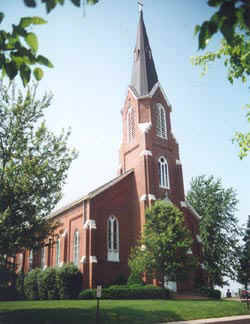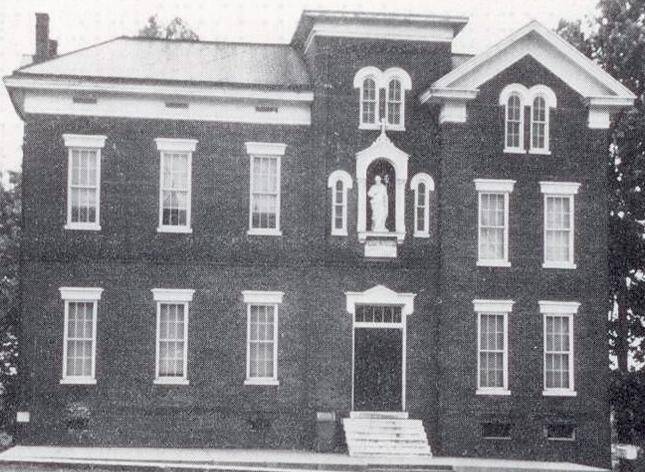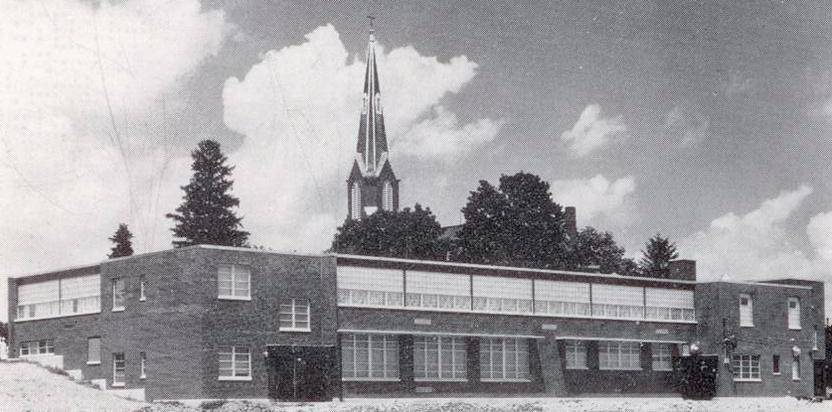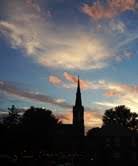History of our Parish
 Saint Joseph is a community about eight miles northwest of Evansville. Settled in the early nineteenth century—primarily by German immigrants—St. Joseph’s history is necessarily the story of craftsman, farmers, and common laborers whose ancestors were willing to “make bread out of stone.” Wrestling a livelihood from the earth, they built a foundation upon which the parish stands firm today.
Saint Joseph is a community about eight miles northwest of Evansville. Settled in the early nineteenth century—primarily by German immigrants—St. Joseph’s history is necessarily the story of craftsman, farmers, and common laborers whose ancestors were willing to “make bread out of stone.” Wrestling a livelihood from the earth, they built a foundation upon which the parish stands firm today.
The area around St. Joseph was first developed in 1817. Trees that had covered the rolling hills gave way to farms and homes and families. And the settlers began to see themselves as a community--with spiritual as well as physicals needs. Missionary priests roamed the countryside in those days--sent from established parishes in northern Illinois and eastern Kentucky. In 1836, one such missionary, Redemptorist Father Czackart became the first recorded priest to visit the area. He celebrated the area' s first Mass in the house of the Widow Weiss in 1836.
As the community grew a needed developed for permanent missionaries to more consistently serve the faithful. In April of 1840, newly ordained Father Roman Weinzapfel came to set about this work. Under his leadership, the community members set about building a two-story log church in 1841. The second floor served as the church and the first floor housed a much needed school and primitive residence for visiting missionaries. By now the congregation had fifteen families and was an official mission parish with the Diocese of Vincennes.
The congregation continued to grow. And as the community became more stable and more prosperous, a desire to build an better--more permanent--church grew, too. Land that is today the parish campus was purchased and the congregation set about building a new church. The cornerstone of the new brick church--erected precisely at the present day church site--was laid on May 28, 1850. Due in large part to the industriousness of the parishioners who did much of the construction work, the new church was completed eleven months later, in May, 1851.
 In 1875, three members of the Franciscan Community in Oldenburg, Indiana came to teach and live in the old log church/school building. They were part of a movement of Franciscan sisters who began to make their mark in the Midwest soon after the order was founded in 1851 by Moher Theresa Hackelmeier In large part, due to their efforts and financial contributions, a new school was built in 1879. This two-classroom structure served not only as school but as a residence for the sisters who taught in the school. Facilities for all remained primitive by modern standards. Children in grades one through seven (an eight grade was added in the early 1900's) shared two rooms. The prives--used until 1959--stood several yards behind the school and a wood stove heated each room. This school served the parish for the next 80 years. The total cost for the school was $6,000, with $1,600 being contributed by the Franciscan Community.
In 1875, three members of the Franciscan Community in Oldenburg, Indiana came to teach and live in the old log church/school building. They were part of a movement of Franciscan sisters who began to make their mark in the Midwest soon after the order was founded in 1851 by Moher Theresa Hackelmeier In large part, due to their efforts and financial contributions, a new school was built in 1879. This two-classroom structure served not only as school but as a residence for the sisters who taught in the school. Facilities for all remained primitive by modern standards. Children in grades one through seven (an eight grade was added in the early 1900's) shared two rooms. The prives--used until 1959--stood several yards behind the school and a wood stove heated each room. This school served the parish for the next 80 years. The total cost for the school was $6,000, with $1,600 being contributed by the Franciscan Community.
The community continued to grow and prosper and, as a more established parish, St. Joseph oversaw the operation of a small school in St. Margaret's mission parish--the site of present day Resurrection Catholic Church. With paid work at a minimum in rural nineteenth century Vanderburgh country, the parish of St. Joseph operated on a tight budget. In a typical year-1886-the total receipts for the year were $1,223.70. The community continued to grow, now numbering some 120 families and the need for a larger church became a growing concern. The congregation had to act more quickly than planned because, on September 11, 1886, fire destroyed the church building. It's loss was estimated at $8,000 and there was no insurance plan to cover it. On April 17, 1888 the cornerstone for a new church building was laid and the church was dedicated on November 17, 1888 for a total cost of $15,000. According to newspaper accounts, "the new church is quite a large one for a county church measuring 80 by 125 feet." This church continues to serve the people of the parish, some 143 years later. In the ensuing years, new church bells, statues, stations of the cross and other appointments were added,
The community continued to grow as they entered a new century. While most of the parishioners lived on small family farms, industry drew an increasing number of people to work in Evansville. In those days, visiting or working in Evansville could prove to be a challenge for the German speaking people of St. Joseph. As late as 1913, 72 years since the beginning of the parish, German was the sole language used in the parish classroom.
And the community continued to grow. A new residence for the pastor was built in 1900 at a cost of $3,000. The years of the depression proved to be particularly challenging for the congregation. Only with money loaned to the parish from several families was the parish able to pay its bills. Still, in 1936 a new residence for the ever-changing band of dedicated sisters was built at a cost of $6,000. Gas lights, installed in 1916, gave way to electricity, as wiring the grounds took place during the spring of 1930. Telephones were hooked up for the parish in 1932
 Like much of the country following WW 11, the congregation grew with the "baby-boom" generation. The need for a new school building became apparent and in 1958 a new school was constructed at a cost of $237,000. The make-up of the parish underwent changes as well. More and more people began to work in Evansville, and the parish changed from being primarily a farming community to a suburban community of Evansville.
Like much of the country following WW 11, the congregation grew with the "baby-boom" generation. The need for a new school building became apparent and in 1958 a new school was constructed at a cost of $237,000. The make-up of the parish underwent changes as well. More and more people began to work in Evansville, and the parish changed from being primarily a farming community to a suburban community of Evansville.
The congregation continued to grow and to meet the societal challenges of post war America. The 1950's drew to a close with a new modern school and a new Pope in Rome. With the new decade came Vatican II's sweeping changes. The Roman Catholic Church across the world began the slow process of transition. Some saw new opportunities, others saw tradition die, when masses were said in English for the first time during 1967.
If time brought change in tradition, it also took its toll on the church itself. The renovation of 1940 ere crumbling in 1966 and by 1968 a major renovation of the church was undertaken. And the community continued to meet challenges in maintaining the school and the parish. Throughout it's history, not only has there been a long standing tradition of people taking on many of the jobs of keeping the parish buildings maintained, they also developed a long tradition of service and outreach to the larger world. One example of this is the twenty-five partnership with the people of St. James Parish in Plaine du Nord which began in 1988 with a visit to the parish by Fr. Francis Schroering, Pastor of the parish and Gilbert Fehrenbacher, a parishioner and deacon of the church.
By 1991, the parish was set to the celebrate their 150th anniversary. To commemorate this event, the parish undertook the project of building a home for Habitat. In addition, a major renovation of the church was undertaken, including building a new mahogany altar, baptismal font, cross and refurbishing of the church pews. On April 1, 1990, Bishop Gerald Gettelfinger joined the community to dedicate the new altar and celebrate the 150th anniversary of the parish.
The next twenty-two years in the life of the parish saw more changes. The congregation continued to grow. As the school building got older and other needs, particularly a gym/multi-purpose building became more necessary, the people of the parish undertook a major building campaign to build a multi-purpose facility, add classrooms for pre-school, science and library, administrative offices and meeting rooms as well as air-conditioning the building. The $1.4 million campaign was five times the cost of the original school. And even this was not enough as unforeseen expenses for asbestos removal and water treatment plant updates added more than $200,000 to the projected costs. Parishioners not only provided money but also well over $200,000 in contributed services. Ground was broken in 1997 and the building was completed in 1998. By 2003 the building had been entirely paid for.
In 2003, a follow-up campaign was begun to complete the work that was left undone by the first capital campaign. Through this campaign, four additional classrooms were built, energy efficient windows installed, a new science lab, library and computer lab were built and a new boiler was installed in the school. All told, another 1.3 million dollars of improvements. By 2008, this project had also been completely paid for. And the work of education continued—new students, new teachers, new technological advances, new education standards. In 2008, another campaign was begun to, among other things, put a new roof on the original school building, dedicated some fifty years ago. Over $350,000 was solicited and raised to complete this project.
St. Joseph has come a long way from the days of log churches, one room schools, dirt roads and wago n trains. The German immigrants are now fully integrated, with persons from every corner of the world. In 1885, the parish operated on $1,326 for the year. In 2013, the expenses for the parish totaled over $1.3 million. The parish school started with three teaching sisters in 1875. Today one sister is part of a staff of twenty-four people. In 2013 not many of he St. Joseph parishioners earn their sole livelihood as farmers--but the parish still has more than its share of farmers, fine craftsmen and craftswomen. In 1841, fifteen families gathered to form a community in the wilderness. Today some 530 families call St. Joseph their parish.
n trains. The German immigrants are now fully integrated, with persons from every corner of the world. In 1885, the parish operated on $1,326 for the year. In 2013, the expenses for the parish totaled over $1.3 million. The parish school started with three teaching sisters in 1875. Today one sister is part of a staff of twenty-four people. In 2013 not many of he St. Joseph parishioners earn their sole livelihood as farmers--but the parish still has more than its share of farmers, fine craftsmen and craftswomen. In 1841, fifteen families gathered to form a community in the wilderness. Today some 530 families call St. Joseph their parish.
Today, St. Joseph Parish continues to be a community of joyful, active, faith-filled people who give thanks to God by generously sharing their individual gifts and talents to serve the needs of all.It is called by the Holy Spirit to proclaim the work of the Lord through Christian actions of faith, love and service to all members of God’s family. With their strong commitment to the parish community and Catholic traditions, parishioners strive to dedicate their time, talent and treasures to strengthen the spiritual life and Christian values within and beyond the boundaries of the local faith community. This strong sense of Christian community, developed over the past 160 years, has been built upon worship, education and service.
The forefathers of St. Joseph Parish labored to make bread out of stone, and today, the parish is called to do the same. Embracing an entire world of strangers and strange events—from refugees to the homeless, from global warming to AIDS—as a Christian community, this labour is never done.
